February 2024
The global corporate wellness market size accounted for USD 68.02 billion in 2025 and is forecasted to hit around USD 129.44 billion by 2034, representing a CAGR of 7.41% from 2025 to 2034. The North America market size was estimated at USD 25.66 billion in 2024 and is expanding at a CAGR of 6.93% during the forecast period. The market sizing and forecasts are revenue-based (USD Million/Billion), with 2024 as the base year.
The global corporate wellness market size was calculated at USD 63.68 billion in 2024 and is predicted to increase from USD 68.02 billion in 2025 to approximately USD 129.44 billion by 2034, expanding at a CAGR of 7.41% from 2025 to 2034.
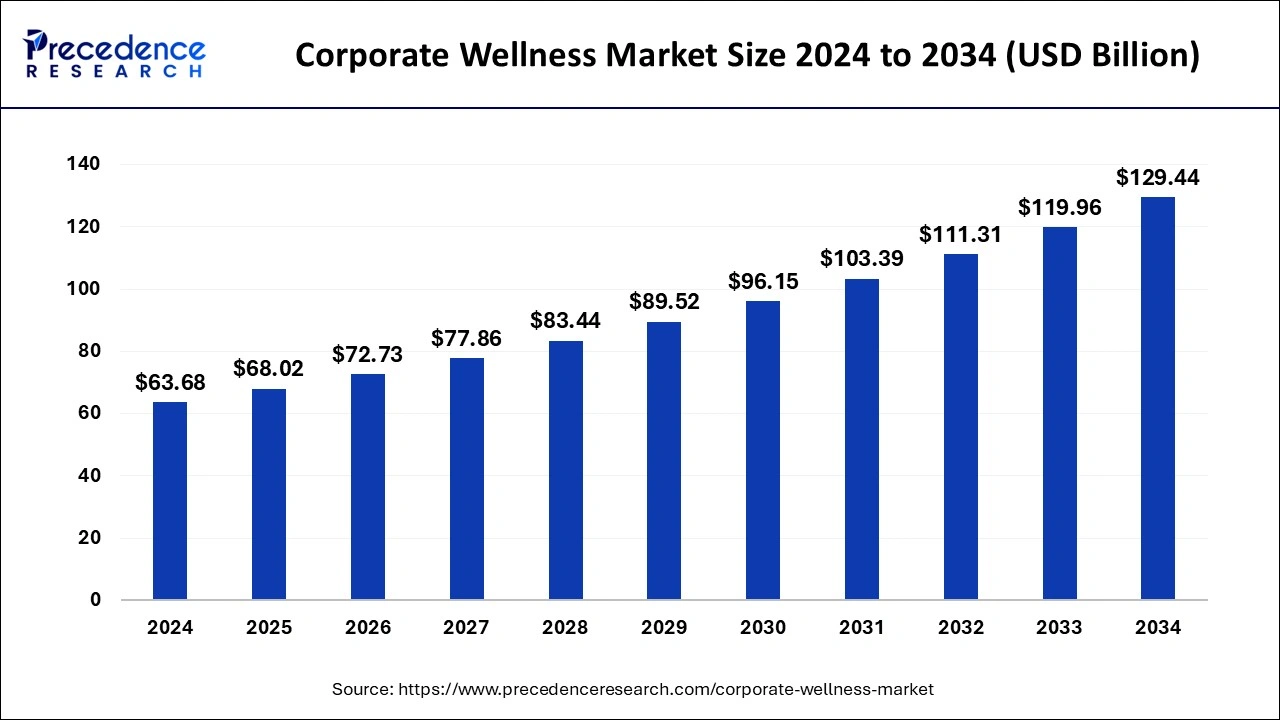
The U.S. corporate wellness market size was exhibited at USD 22.01 billion in 2024 and is projected to be worth around USD 42.11 billion by 2034, growing at a CAGR of 6.76% from 2025 to 2034.
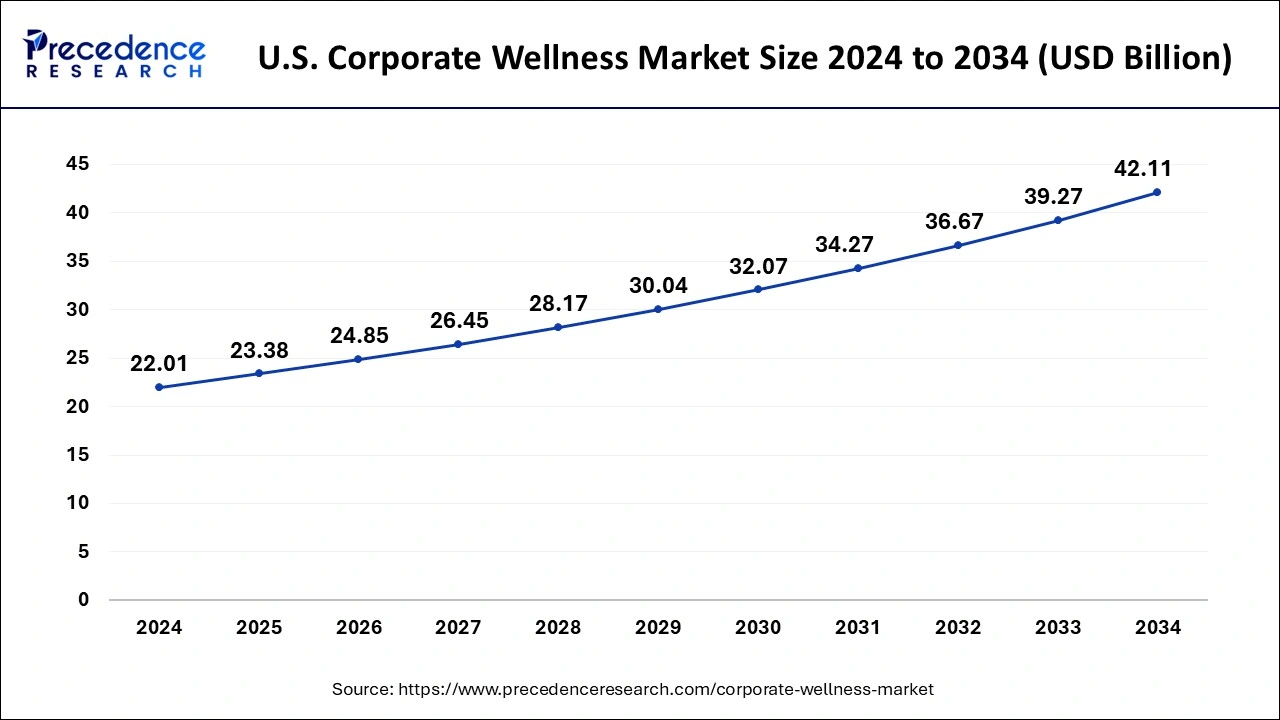
North America emerged as the global leader in the corporate wellness market in terms of revenue share in the year 2024. As per RAND employer survey, nearly 50% of the corporate owners in the U.S. provide wellness programs to their employees inside their organization. In addition, significant dominance of the office culture in the North America influence the corporate owners in the region to implement such services or programs to benefit their employees with good health.
However, the Asia Pacific witness flourishing growth at a CAGR of 9.30% over the forecast period owing to prominent rise in the working population along with increasing awareness regarding health management of employees. A large workforce in a growing economy has a better chance of attracting wellness market growth in the coming years. The market is rapidly gaining traction in the region, and many businesses have begun to invest in it because of its value to employees. The potential for further adoption in the region is enormous thereby contributing to the market growth.
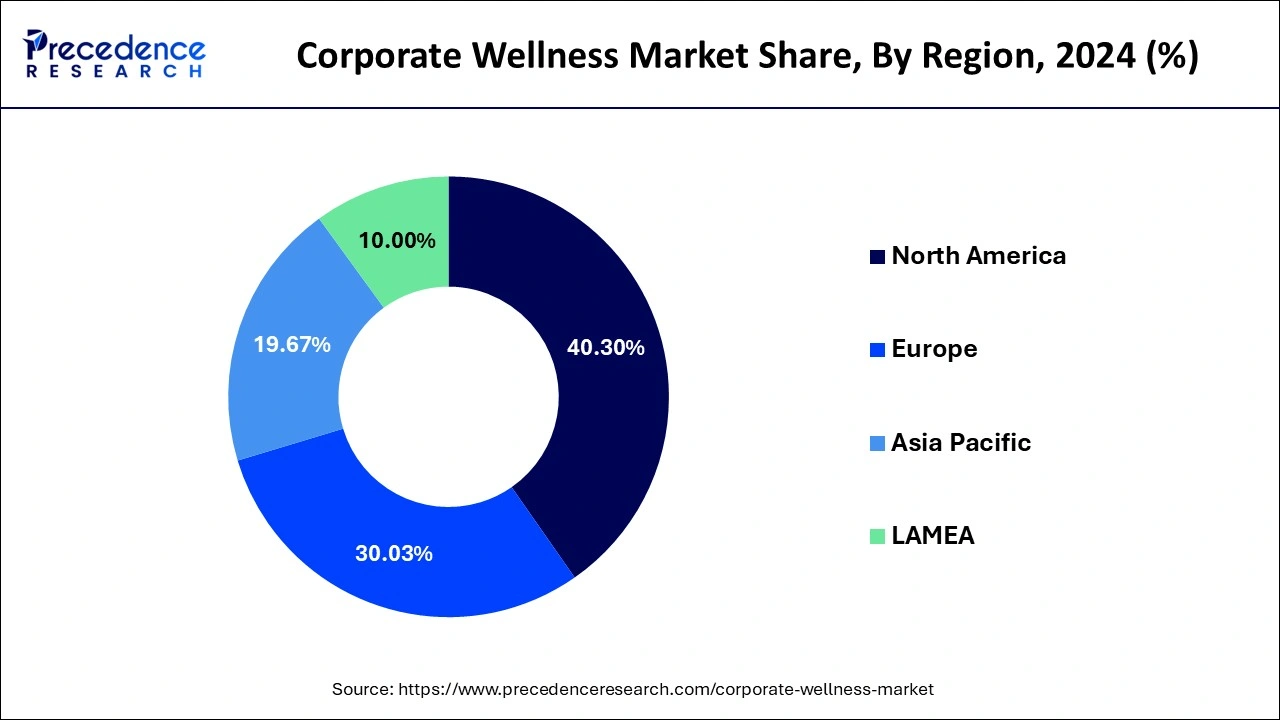
Asia-Pacific Corporate Wellness market is expected to grow strongly in the forecast period as it involves high government initiatives that encourage human resources development. In addition, increase in number of cases of chronic diseases such as cancer and stress disorder is driving the market growth. Moreover, rising aging working-class population in Asia-Pacific region is going to be beneficial for market whereas corporates are spending huge amount on healthcare infrastructure and act as a key opportunity for meeting unmet corporate wellness needs in the region.
In addition, the region offers prominent scope for the western companies to expand their portfolio in the Asian countries, this trend also promote the jobs in the region in turn fuelling the demand for corporate wellness programs significantly.
Several industries and companies have started heath programs for their employees that are expected to boost the market growth of corporate wellness in the coming years. These programs help companies to augment their productivity by reducing the overall operational cost. Further, rising awareness for the health benefits and wellness of the employees also projected to drive the market growth significantly over the forecast period.
Through wellness programs both employee and employer can gain high benefits. As presently, people prefer those workplaces that have good work culture as well as health improvement plans expect of daily task. Health awareness or improvement programs impact positively on the organizational environment and culture. In addition, employees also prefer to adopt incentive-based wellness activities as they play a significant role in employee’s motivation.
| Report Highlights | Details |
| Market Size by 2025 | USD 68.02 Billion |
| Market Size by 2034 | USD 129.44 Billion |
| Growth Rate from 2025 to 2034 | CAGR of 7.41% |
| Base Year | 2024 |
| Forecast Period | 2025 to 2034 |
| Segments Covered | Service, Category, Delivery Model, End-use |
| Regional Scope | North America, Europe, Asia Pacific, Rest of the World |
Longer working hours and a longer life expectancy
There are various crucial factors which affect the market and lead to upward movement of corporate wellness sector. They are significant for holistic approach that means for employees and employers to bring out the optimum output and maintain the well-being of the work culture. With the growing competition and to withstand in the business world, the employees have to devote longer working hours which demands healthy and longer life expectancy of them. In order to maintain the efficiency and well-being of the employees, the organisation opts for various wellness programs and policies which ultimately bolster the corporate wellness market.
Growing awareness about stress and prevalence of chronic diseases
The working-class population has become workaholic and occupied that they tend to take stress and fails to manage things in life which adversely affects the physical and mental health. The increased depression and stress have created the need for behavioral and mental health management of the employees which resulted in demand for wellness programs by the organisations for its employees. Therefore, this propels the market growth and serves as the key purpose for the demand of the health products and services.
A Big Change in Well-Being Attitudes
A modern sense of belonging linked to fitness which is deeply prized in contemporary society is opening new doors. As a result of digitalization, which is pushing global market expansion, customers are looking for ways to detox from their digital frenzy and regain their time for personal advancement, harmony, and fitness. Various practices are followed namely meditation, yoga, stress relieving programs, detoxifying challenges to boost the immunity by the target audience for the fitness and health concerns. Therefore, the growing concern for health and changing attitude towards health is driving the market.
Rising dominance of Artificial Intelligence
The global corporate wellness market will be transformed by the arrival of a new age of personalized education and solutions that cater to each employee's individualized well-being through AI. Several companies are turning to artificial intelligence to maintain employee interaction between human touch points, create a more detailed profile of their workers in real time and help them scale up their wellness plans without relying heavily on human resources. AI-enabled services recognize patterns, predict how real health problems or statistics will play out in the future, and devise a strategy to keep illnesses and other health and well-being issues. Hence, it is significant factor for the market growth.
Dearth of qualified and skilled professionals
According to the Health Resources and Services Administration, the number of adult psychiatrists in the United States is expected to drop by 20% by 2030. The shrinking number of fresh experts entering these professions is the key reason for the shortage of qualified and skilled professionals. In emerging countries, the shortage of mental health experts and other professionals suitable for corporate wellness programs is much more apparent. For instance, In India, there are just 0.75 psychiatrists per 100,000 inhabitants. This scarcity of appropriately skilled personnel obstructs the ability to launch and manage effective, holistic corporate wellness programs, thus limiting the market's growth especially in the developing economies.
Budgetary Constraints
The occupational health policies involve huge cost for the various health and wellness programs. Sometimes, companies set up gyms which require regular maintenance of Equipment and high payment to the professionals and trainers, which add to the operational cost of the organization. This leads to the overall cost of the organization and mostly the huge workplace cost has to be borne by the organization which are the key factor hindering the market growth of corporate wellness programs. This is even more common in medium and small scale organizations.
According to a research, nearly half of employers believe that cost assumptions regarding workplace wellness programs are the most significant barriers to employee happiness. It requires money to buy plants to improve the workplace environment or to organize an event for employee well-being. Despite the fact that studies show that investing in employee health programs can yield a return of $3 to $4 for every dollar spent, many businesses may not have the financial resources to make the first commitment.
Low awareness regarding the corporate wellness programs
According to numerous studies, a communication gap is the primary reason why many employees are unaware of their company's health programs. Even if they are aware that such programs exist at their place of business, many are unaware of the benefits or other aspects, and hence have little interest in participating or engaging in them. While some employees may lack the necessary drive to make beneficial changes, others may just be unwilling to change. Employers must provide employees with all of the specifics and pertinent information about corporate wellness programs in order to ensure that they step outside of their comfort zone. Employees must be informed about the purpose, aims, and potential rewards, and they must be encouraged to participate. Offering incentives and awards can help entice people to participate. Employees are very likely to continue after they observe the good changes and benefits. Therefore, lack of awareness regarding the corporate wellness programs restricts the market growth to certain extent.
High cost involved
The occupational health policies involve huge cost for the various health policies and wellness programs. Sometimes, companies set up gyms which requires regular maintenance of Equipments and needs to handful of fees to the trainers which adds to the operational cost of the organisation. This leads to the overall cost of the organisation and mostly the huge workplace cost has to be borne by the organisation which are the key factor hindering the market growth of corporate wellness programs.
Stringent regulatory requirements
The regulatory authorities of several nations have jotted stringent regulations for the commercialization of services. There are chances of different regulation by Government and Organizations towards employee having multiple business locations. This will affect standardization of the services. Also, the operational hurdles posed by the service industry and large number of employees decelerates the growth of the market.
The focus on workforce health is becoming more prominent globally.
Companies now days are focusing towards employee’s health and make sure their employees are healthy. According to the CDC, six out of ten persons in the US have a chronic disease (e.g., stress, lung disease, stroke, Alzheimer's, diabetes, renal disease), and four out of ten have two or more disorders.
The figures on health-care costs are staggering:
These expenditures can be drastically lowered if employees are encouraged to focus on developing better daily routines and lives. Taking the stairs, drinking less soda, getting more sleep, and minimizing stress at work are all habits we can develop, and the behavioral changes that occur can have a good impact on our job.
For instance, Virgin Pulse's daily engagement platform can motivate customers to do things like meditate every morning, take the stairs, drink more water, eat healthier meals, and save money. By applying these tools, thousands of firms using Virgin Pulse's program have witnessed a 16 percent reduction in healthcare claim costs per member, on an average. Therefore, to determine where the population's problems and opportunities are, as well as the financial and health benefits that may be achieved by addressing them through corporate wellness programs offer lucrative opportunities for the market growth.
The health risk assessment segment led the global corporate wellness market in terms of revenue share of over 21.48% in the year 2024. The Health Risk Assessments (HRAs) segment is estimated to reach USD 28.18 billion by 2034, growing at a CAGR of 8.40% during the forecast period (2025-2034).
Screening efforts to detect health concerns and the implementation of appropriate interventional techniques to promote a healthy lifestyle among employees are the mainstays of corporate wellness programs. Around 80% of firms who provide corporate wellness services choose to examine their employees' health risks. In the corporate wellness solutions market, the health risk assessment sector has the largest market share by service offering. The utility of this service for early detection and mitigation of health risks in employees, as well as reduced absence owing to health concerns and decreased healthcare expenditures, accounts for a substantial portion of this market.
The corporate wellness programs under health risk assessment segment include screening activities to identify risks and adopt proper interventional strategies to encourage a healthy lifestyle among employees. Nearly, 80% of the employers provide health risk assessment program and other well-being services for their employees. In today’s era, the work culture has changed drastically that may leads to the body pain, and other various risk to health as the employees have to sit for long hours in the office. In addition, their daily food habits along with the increasing pollution level also impact the daily lives of employees. Therefore, these wellness programs impact significantly in improving lifestyle into a healthier one.
Moreover, stress management segment is growing at the fastest CAGR of 9.10% during the forecast period owing to increasing work stress and other daily life stress among the employees. These stress management programs helps employees to properly manage their office along with their personal life. As said, a healthy mind resides in a healthy body, so for proper an effective functioning of brain stress relieving programs or management skills are very important.
| Service Segment | 2024 (%) |
| Fitness | 14.64% |
| Health Risk Assessment | 21.48% |
| Health Screening | 6.66% |
| Smoking Cessation | 15.81% |
| Stress Management | 13.26% |
| Nutrition & Weight Management | 18.11% |
| Others | 10.04% |
The Organizations/Employers segments encountered the largest revenue share of 50.37% in the global corporate wellness market in 2024 with a cagr of 7.90%. Organizations/Employers used to focus on health benefits when talking about employee well-being. These days, employee wellbeing is more than just absence of illness among employees. Employee wellbeing is tied in with advancing the strength of all employees. With the ongoing COVID-19 flare-up, numerous businesses saw the effect worker prosperity has on their performance, and thus on the business results.
The Fitness & Nutrition Consultants segment accounted for 28.91% of revenue share in 2024. Fitness consultants satisfy the task of figuring and facilitating customized exercise programs that will help a diverse group of people feel better and easily thinking about themselves. The nutrition consultant reviews a client's current eating habits and prosperity goals and puts together a meal plan and educates the client on proper nutrition and choosing foods that help treat and prevent certain diseases and conditions the client may have.
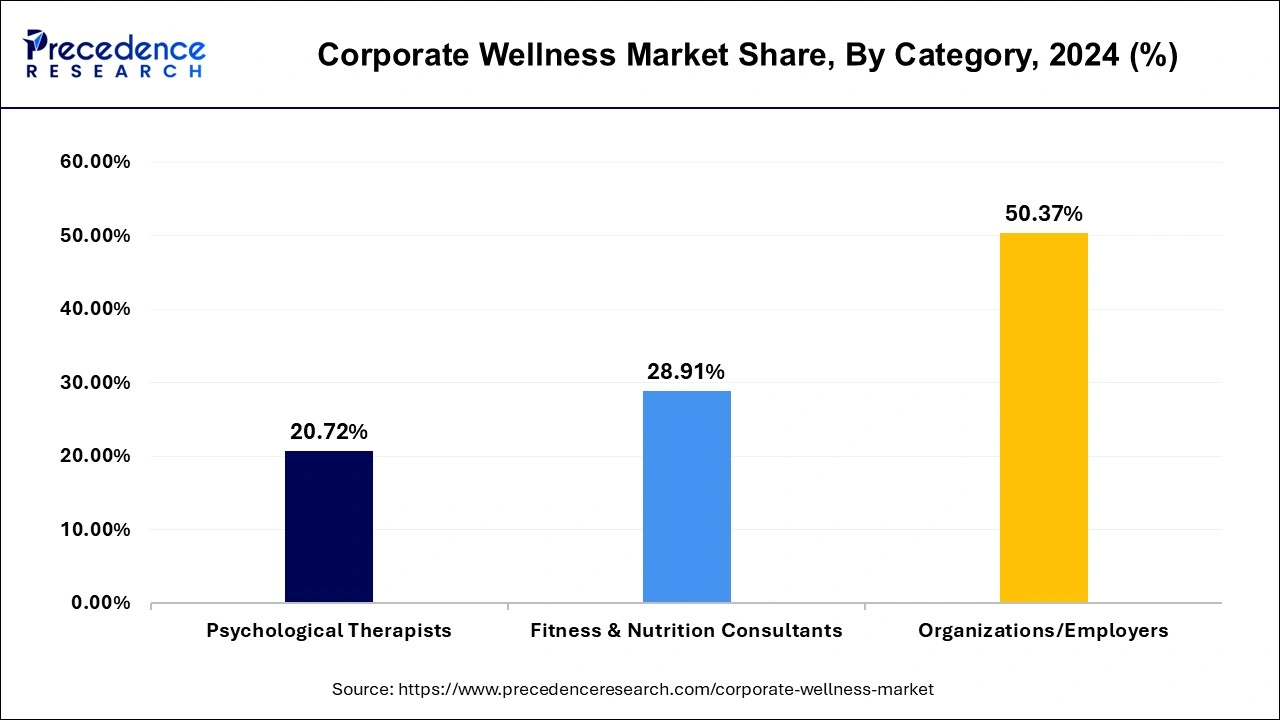
The Psychological Therapists contributed 20.72% revenue share in the the global market in 2024. A psychological therapist’s treat individuals who have emotional issues and mental illnesses/problems by utilizing the talk treatment and try to manage the general emotion unrest and illness. Sometimes daily life trouble/issues like anxiety disorder, mood disorder, personality disorders, addictions etc. are very big challenges for an individual. A psychological therapist diagnoses and treat these issues.
Onsite delivery model encountered the highest revenue share in the global corporate wellness market in 2024 and is projected to witness the fastest growth over the forecast period. Onsite wellness programs offer a personal touch to the employee’s well being along with the facility to exercise under the guidance of trained coaches and fitness consultants to meet their personal health requirements.
Large scale organizations contribute a prominent revenue share in the global corporate wellness market in 2024. As per RAND, nearly 70% of the organizations had invested in health screening services or programs in the year 2013. A detailed study of the corporate wellness programs indicates that a successfully implemented wellness program can yield around 3:1 return on investment.
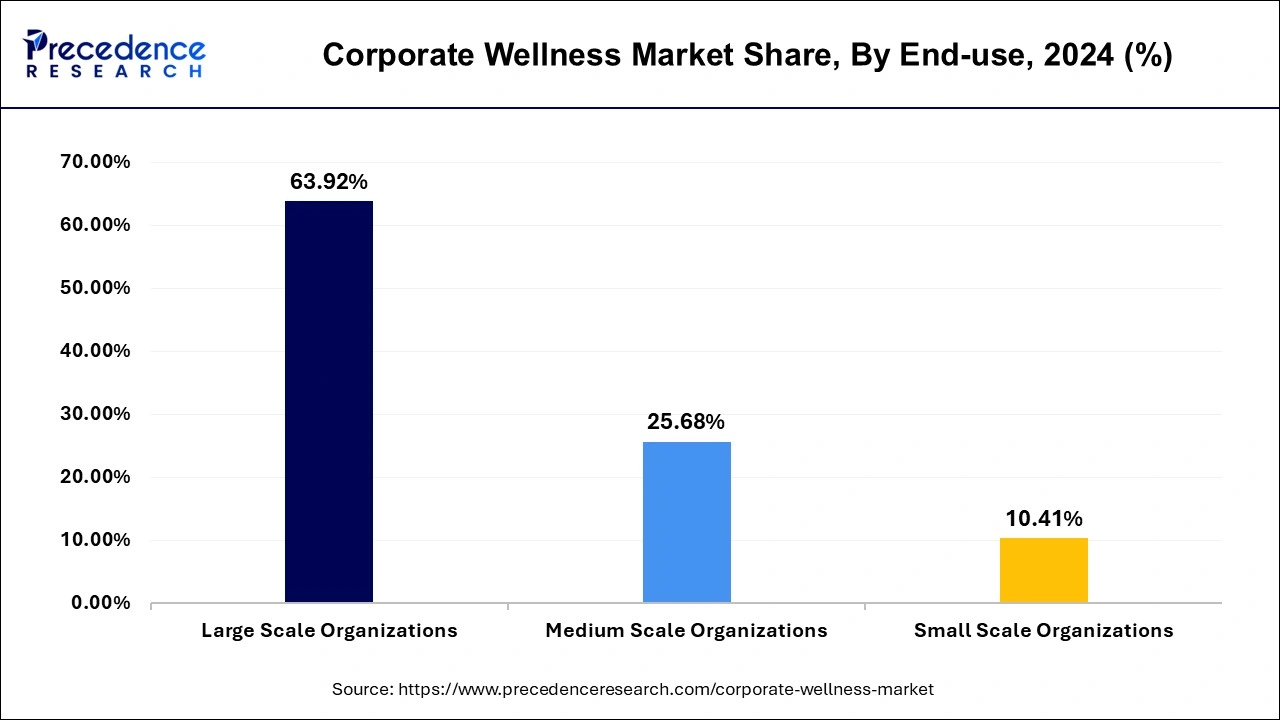
In addition, awareness among the corporate owners for investing in their employee’s health improvement program that in return will boost their services and enhance their company’s performance per year. Similarly, small-scale organizations also implement corporate wellness programs by outsourcing them from different service providers.
By Service
By Category
By Delivery Model
By End-use
By Regional Outlook
For inquiries regarding discounts, bulk purchases, or customization requests, please contact us at sales@precedenceresearch.com
No cookie-cutter, only authentic analysis – take the 1st step to become a Precedence Research client
February 2024
March 2025
December 2024
March 2025